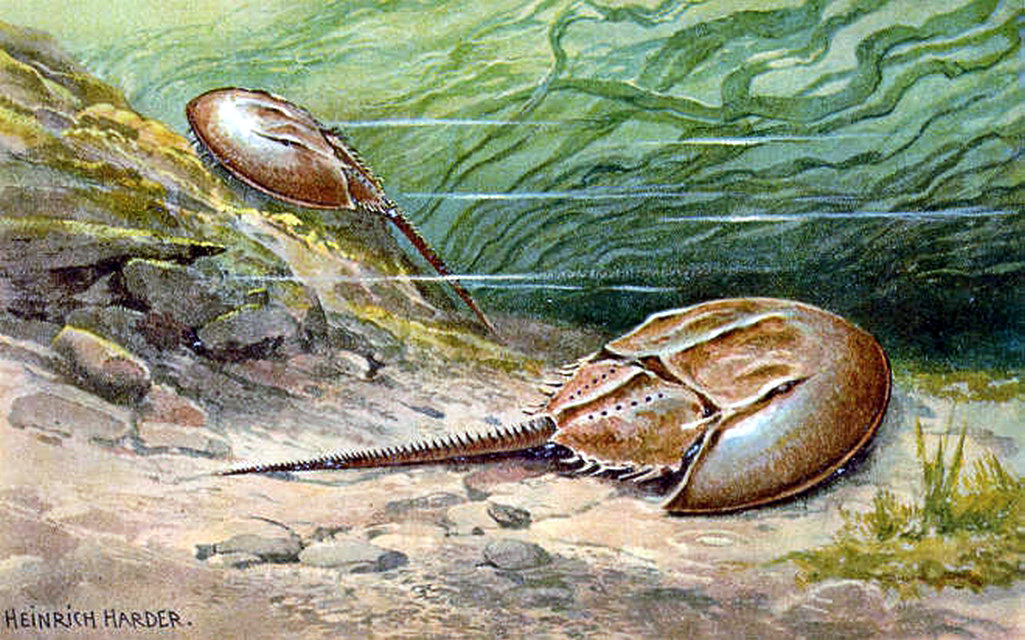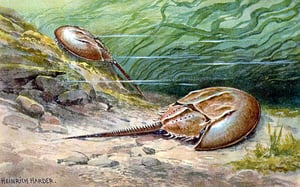A Crab’s Final Journey, The Longest Mortichnial Trackway in the Fossil Record.
Horseshoe crabs are marine arthropods of the family Limulidae, they are invertebrates, meaning that they lack a spine. Horseshoe crabs live primarily in and around shallow ocean waters on soft sandy or muddy bottoms. Because of their origin 450 million years ago, horseshoe crabs are considered living fossils.
The entire body of the horseshoe crab is protected by a hard carapace. The horseshoe crab has five pairs of legs for walking, swimming, and moving food into the mouth, each with a claw at the tip, except for the last pair. As in other arthropods, a true endoskeleton is absent, but the body does have an endoskeletal structure made up of cartilaginous plates that support the book gills. Behind its legs, the horseshoe crab has book gills, which exchange respiratory gases, and are also occasionally used for swimming. They are more often found on the ocean floor searching for worms and molluscs, which are their main food. They may also feed on crustaceans and even small fish.
The Solnhofen Formation in Germany is known for the exquisite fossils that have been excavated from its limestone deposits. One of the most dramatic of these fossils is this mortichnial trackway – a 9.7 meter fatal trek of a small but determined horseshoe crab. Thru scientific research, paleontologists have attempted to reconstruct the final moments of the ill – fated crab.
The entire trackway is 9.7 meters long. The ill – fated journey begins. The horseshoe crab landed at the bottom of the Solnhofen lagoon, and began to walk along its muddy bottom.
The detail is extraordinary; the long line in the center of the track is the crab’s telson (tail) dragging along the soft ocean floor. Traces of the legs can be seen on either side.
Here, the impression of the crab’s shell can be seen. The crab stopped to rest, or perhaps tried burrowing into the sediment. Regardless, it decided to continue its trek.
The track becomes chaotic. The water in the Solnhofen lagoon was anoxic, containing very little oxygen to support life. The horseshoe crab was slowly asphyxiating to death in the lifeless lagoon
The death march concludes – the horseshoe crab succumbs to the anoxic water and dies. Sediment quickly covered the crab and its final 9.7 meter journey, preserving it for over 145 million years.
The Landing Site
Horseshoe crabs swim upside down. The displaced mud – seen here, at the beginning of the trackway – is most likely a result of the crab landing and turning itself right side up, using its “tail,” called a telson. From here, the death march begins.
The Rest Stop
Ichnofossils contain no skeletal parts; they are traces left behind by ancient plants and animals. These include trackways, burrows, even fossilized dung. Here, the impression of the front of the horseshoe crab’s shell can be seen in the rock. It is thought the crab stopped to rest and tried to burrow in the mud. This evidence of behavior could not be learned from the crab’s fossilized body, which is why ichnofossils are so valuable in paleontology.
The Perpetrator
Horseshoe crabs are commonly called “living fossils.” They first appeared over 400 million years ago, and have remained virtually unchanged since that time. This particular species of horseshoe crab – Mesolimulus walchi – is common in the Solnhofen Formation. There are many examples of Mesolimulus death tracks from this fossil desposit, but none are as long and unique as this track.
Back to Life
Despite beauty and remarkable preservation, most fossils only provide a reconstruction of prehistoric organisms. This mortichnial trackway – the final journey of the horseshoe crab – has brought it to life in a way a skeleton alone could never accomplish. The movements of this crab are immaculately preserved in the limestone of the Solnhofen, allowing paleontologists to study its behavior in addition to its fossil remains. It is a small but personal look into a 150 million year old prehistoric world.




